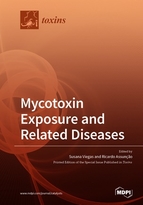Mycotoxin Exposure and Related Diseases
A special issue of Toxins (ISSN 2072-6651). This special issue belongs to the section "Mycotoxins".
Deadline for manuscript submissions: closed (31 October 2019) | Viewed by 50740
Special Issue Editors
Interests: environmental health; occupational toxicology; exposure and risk assessment; mixtures; biomonitoring
Special Issues, Collections and Topics in MDPI journals
Interests: food toxicology; mycotoxins; chemical mixtures; risk assessment and risk–benefit assessment of foods; interaction between foods/diets and human health
Special Issues, Collections and Topics in MDPI journals
Special Issue Information
Dear Colleagues,
Mycotoxins are considered the most frequently occurring natural food contaminants in human and animal diets. Considering their potential toxic and carcinogenic effects, mycotoxin exposure assessment assumes particular importance in the context of health risk assessment. The magnitude of a given exposure will allow to derive the associated risk and the potential to the establishment of a disease. Although food ingestion is considered a major route of human exposure to mycotoxins, other contexts can also imply exposure, such as specific occupational environments where exposure to organic dust also occurs due to the handling of organic materials. Animals could also be exposed to mycotoxins, through consumption of contaminated feed, subsequently entering in the food chain and thus constituting a source of exposure to humans.
All these exposure scenarios constitute an overall internal body burden of mycotoxins in humans. Human biomonitoring is considered a quite new frontier for the establishment of the real human internal exposure to mycotoxins. Combined with toxicological and epidemiological data, human biomonitoring data relate to exposure and disease.
Although several studies have summarized the potential outcomes associated with mycotoxin exposure, there are still major gaps in data that allow to recognize that mycotoxins are the cause of diseases. Aside from aflatoxin B1, the most potent natural carcinogen known, and whose link with morbidity/mortality of both animals and humans has already been made, for other mycotoxins there are still several question marks. Moreover, the potential exposure to mycotoxin mixtures that may exhibit interactive activity and/or exert some biological function converging in the same molecular pathways still needs to be considered in the exposure and risk assessment and in the regulatory landscape.
We look forward to receiving your contributions for this Special Issue, in the form of original research or review papers which will shed light into the different perspectives of mycotoxin exposure and their implications for the establishment of a disease. No specific restrictions for particular mycotoxins are established.
Prof. Dr. Susana Viegas
Dr. Ricardo Assunção
Guest Editors
Manuscript Submission Information
Manuscripts should be submitted online at www.mdpi.com by registering and logging in to this website. Once you are registered, click here to go to the submission form. Manuscripts can be submitted until the deadline. All submissions that pass pre-check are peer-reviewed. Accepted papers will be published continuously in the journal (as soon as accepted) and will be listed together on the special issue website. Research articles, review articles as well as short communications are invited. For planned papers, a title and short abstract (about 100 words) can be sent to the Editorial Office for announcement on this website.
Submitted manuscripts should not have been published previously, nor be under consideration for publication elsewhere (except conference proceedings papers). All manuscripts are thoroughly refereed through a double-blind peer-review process. A guide for authors and other relevant information for submission of manuscripts is available on the Instructions for Authors page. Toxins is an international peer-reviewed open access monthly journal published by MDPI.
Please visit the Instructions for Authors page before submitting a manuscript. The Article Processing Charge (APC) for publication in this open access journal is 2700 CHF (Swiss Francs). Submitted papers should be well formatted and use good English. Authors may use MDPI's English editing service prior to publication or during author revisions.
Keywords
- Mycotoxins
- Risk assessment
- Human biomonitoring
- Mycotoxin mixtures
- Food and feed
- Occupational exposure
- Health impact
- Toxic effects








